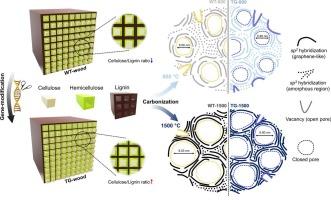通过CRISPR-Cas9工程了解木质纤维素-生物质衍生硬碳阳极的微观结构形成
IF 22
1区 材料科学
Q1 MATERIALS SCIENCE, MULTIDISCIPLINARY
引用次数: 0
摘要
木质纤维素前体的组成,包括纤维素、半纤维素和木质素,在形成生物质衍生的硬碳(hc)的微观结构特征中起着关键作用,包括晶体区域、缺陷、杂原子和开/闭孔,这些都是电化学碱金属离子(AMI)存储性能的关键决定因素。然而,了解木质纤维素原料组成变化与电化学性能之间的相关性是具有挑战性的,因为设计实验模型的复杂性要求对组成因素进行基本控制。在本研究中,我们通过引入使用CRISPR-Cas9技术作为HC模型的前体的基因编辑杂交杨木来解决这一挑战。实验模型阐明了纤维素-半纤维素-木质素组成和炭化温度对hc的化学和微观结构特性的影响及其后续影响。我们对Li+, Na+和K+三种ami的研究结果表明,减少前体中木质素含量对HC阳极内活性位点的形成起着关键作用,从而提高了ami的倾斜和高原储存能力。这些对木质纤维素前体的组成效应的见解为设计针对ami存储优化的高性能hc提供了合理的框架。本文章由计算机程序翻译,如有差异,请以英文原文为准。

Understanding microstructure formation in lignocellulosic-biomass-derived hard carbon anode via CRISPR–Cas9 engineering
The composition of lignocellulosic precursors, encompassing cellulose, hemicellulose, and lignin, plays a pivotal role in shaping the microstructural features of biomass-derived hard carbons (HCs), including crystalline regions, defects, heteroatoms, and open/closed pores, which are critical determinants of electrochemical alkali-metal ion (AMI) storage performance. However, understanding the correlation between the variations in the composition of lignocellulosic raw materials and electrochemical performance is challenging due to the complexity of designing experimental models that demand fundamental control over the compositional factors. In this study, we address this challenge by introducing a gene-edited hybrid poplar wood engineered using CRISPR–Cas9 technology as a precursor for HC models. The experimental models elucidated the effects of cellulose-hemicellulose-lignin composition and carbonization temperature on the chemical and microstructural characteristics of HCs and their consequent influence. Our findings with three AMIs: Li+, Na+, and K+ revealed that reducing the lignin content in the precursors plays a pivotal role in forming active sites within HC anodes, thereby enhancing both sloping and plateau capacities for AMIs storage. These insights into the compositional effects of lignocellulosic-precursors provide a rational framework for designing high-performance HCs optimized for AMIs storage.
求助全文
通过发布文献求助,成功后即可免费获取论文全文。
去求助
来源期刊

Materials Today
工程技术-材料科学:综合
CiteScore
36.30
自引率
1.20%
发文量
237
审稿时长
23 days
期刊介绍:
Materials Today is the leading journal in the Materials Today family, focusing on the latest and most impactful work in the materials science community. With a reputation for excellence in news and reviews, the journal has now expanded its coverage to include original research and aims to be at the forefront of the field.
We welcome comprehensive articles, short communications, and review articles from established leaders in the rapidly evolving fields of materials science and related disciplines. We strive to provide authors with rigorous peer review, fast publication, and maximum exposure for their work. While we only accept the most significant manuscripts, our speedy evaluation process ensures that there are no unnecessary publication delays.
 求助内容:
求助内容: 应助结果提醒方式:
应助结果提醒方式:


